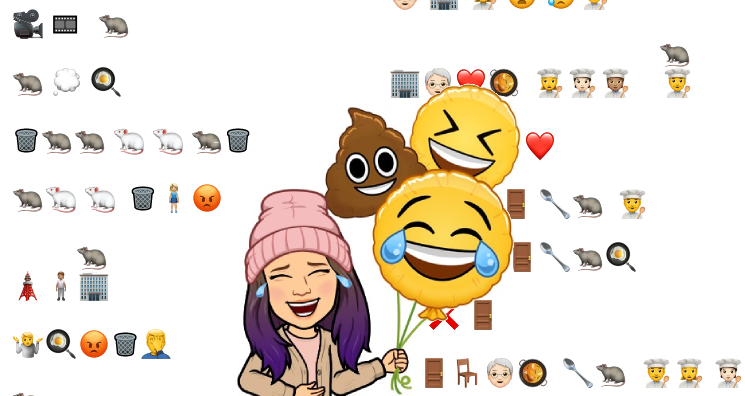 Link to Judy’s entry: https://blogs.ubc.ca/etec540judytai/2021/02/17/task-6-an-emoji-story/
Link to Judy’s entry: https://blogs.ubc.ca/etec540judytai/2021/02/17/task-6-an-emoji-story/
Judy picked the Disney movie, Ratatouille, for her emoji story. She and I both selected a Disney movie with distinct animal characters that can give away the “answer” without really having to read the whole emoji story. Furthermore, both of our choices are quite popular films so the first line with the animal and the defining object (e.g., rat + chef’s hat, or lion + crown) is enough to communicate our ideas.
What I really connected with was Judy’s reflection on readers:
I thought this task was particularly interesting because many of my students that are novice readers tend to become more selective in what they want to read. (Tai)
Judy went on to identify how graphic novels help educators shift their focus to teaching visual literacy and using pictures to assist with understanding text-based elements such as punctuation, italics, and more. While I completely agree with her, I would like to add that in addition to novice readers, emerging readers are also selective with what they want to read!
I recently got a new student from Colombia who speaks very little English. However, as a grade 7 student, she is reluctant to read the easy picture books that are levelled to her reading ability. Furthermore, apps like RAZ Kids are geared towards primary students but not towards intermediate students reading at a primary grade level. However, she really likes reading fanfiction and uses Wattpad to pull texts of any language. She promises to read fanfiction in English, so I let her use it sometimes during silent reading. In some of those stories, authors create fake screenshots of text message conversations, twitter threads, and other social media to create a new type of epistolary work.
What is most interesting to me is her learning to read through these types of works. Unlike RAZ Kids and the levelled readers, these stories employ different types of “text” to communicate meaning. For my student, though she has very limited spoken English, she is a good reader and can pick up meaning through a variety of visual cues. She is learning to read through twitter threads, fake instagram profile screenshots, and the like. It reminds me of what Bolter (2001) calls as “a readjustment of the ratio between text and image in the various forms of print” (p. 48). Rather than this readjustment referring to an increasing amount of visuals to text, the change here is the types of texts and visuals included in published works. Emerging readers who are going on to their teens would much appreciate work that caught up to them and their preferred forms of literacy.
Judy concludes by emphasizing the importance of multimodal learning: teachers incorporate “various senses and experiences into learning, on top of all the required reading, greatly help student’s understanding of the material.” I like her use of the word “transparency” with regards to meaning. Judy links the use of pictures to assist with conveying meaning in a way that is more universal and accessible to all readers, as opposed to text that is less transparent and relies on a student being literate in one specific language.
References
Bolter, J.D. (2001). Writing Space: Computers, hypertext, and the remediation of print. Mahway, NJ: Lawrence Erlbaum Associates, p. 48.
Tai, J. (2021, February 17). Task 6: An emoji story. ETEC 540 Judy Tai Section 65B. https://blogs.ubc.ca/etec540judytai/2021/02/17/task-6-an-emoji-story/